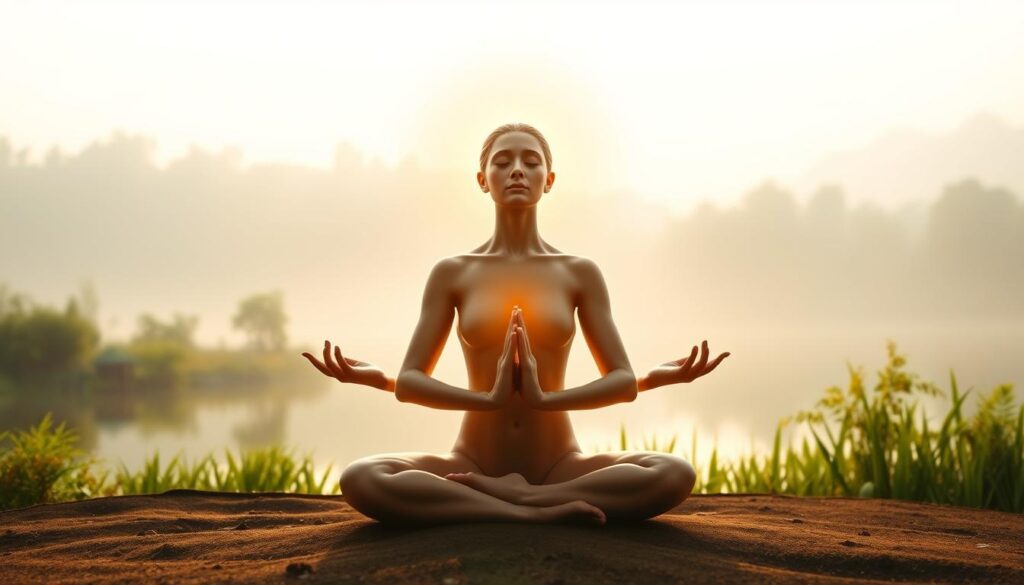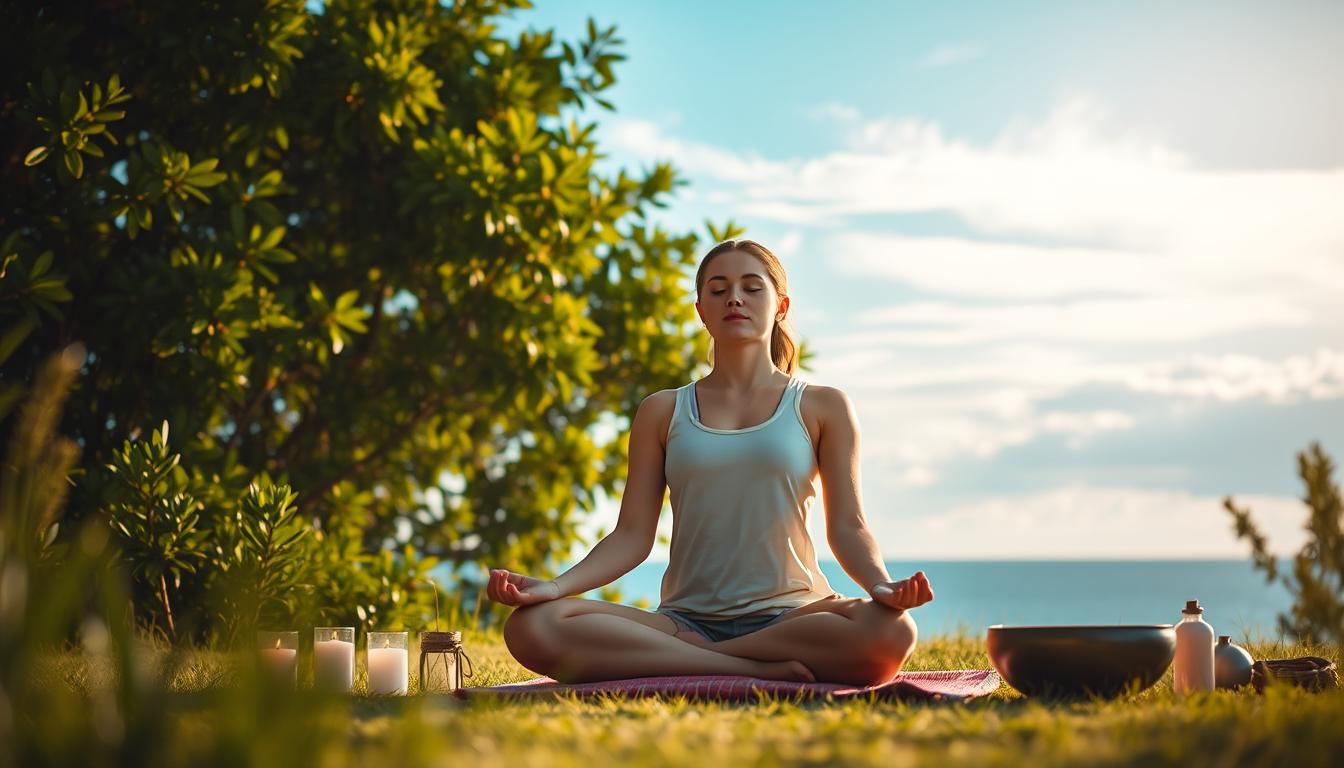In today’s fast-paced world, achieving a balance between mental and physical well-being is crucial. Studies have shown that individuals who practice mindfulness are more likely to experience reduced stress levels and improved overall health. Incorporating simple yet effective mindfulness practices into daily life can have a significant impact on one’s quality of life.
By adopting holistic well-being approaches, individuals can cultivate a deeper connection between their mind and body. This, in turn, can lead to a more balanced and fulfilling lifestyle.
Key Takeaways
- Mindfulness practices can reduce stress levels
- Holistic well-being approaches promote mind-body balance
- Incorporating simple rituals can improve overall health
- A balanced lifestyle leads to improved quality of life
- Mindfulness is key to achieving overall well-being
Understanding the Mind-Body Connection
Understanding the mind-body connection is key to unlocking a healthier lifestyle. The intricate relationship between our mental and physical health is a complex one, influenced by a myriad of factors including our daily habits and overall well-being.

The Science Behind Mind-Body Harmony
The science behind achieving harmony between the mind and body is rooted in the understanding that they are interconnected. Research has shown that mental states can significantly impact physical health and vice versa. For instance, stress can lead to physical symptoms like headaches or fatigue, while regular physical activity can enhance mental health by reducing symptoms of anxiety and depression.
Mind-body practices such as meditation and yoga have been shown to positively impact both mental and physical health by promoting relaxation and reducing stress.
Signs of Mind-Body Imbalance
Recognizing the signs of mind-body imbalance is crucial for taking corrective action. Common indicators include chronic stress, anxiety, depression, and physical symptoms like chronic pain or digestive issues. When we experience an imbalance, it can affect our daily functioning and overall quality of life.
“The way to get started is to quit talking and begin doing.” – Walt Disney
Benefits of Establishing Daily Wellness Practices
Establishing a daily wellness routine can have numerous benefits, including improved mental clarity, enhanced physical health, and a stronger resilience to stress. By incorporating practices such as mindfulness, exercise, and healthy eating into our daily routine, we can promote mind-body harmony and improve our overall well-being.
- Mindfulness practices can reduce stress and improve mental health.
- Regular exercise can enhance physical health and boost mood.
- A balanced diet supports overall health and energy levels.
Morning Rituals for Mind-Body Harmony
Morning rituals play a crucial role in establishing a balance between the mind and body. By incorporating mindfulness practices and self-care routines into your morning, you can set a positive tone for the day.
Mindful Awakening Practices
Beginning your day with mindfulness can significantly enhance your mental clarity and emotional well-being. Two effective practices to consider are 5-minute morning meditation and gentle stretching sequences.
5-Minute Morning Meditation
A short meditation session in the morning can help calm your mind and prepare you for the day ahead. Simply sit comfortably, focus on your breath, and let go of any thoughts or worries.
Gentle Stretching Sequence
Incorporating gentle stretches into your morning routine can improve flexibility and reduce muscle tension. Start with simple neck stretches and gradually move to other parts of your body.
Nourishing Breakfast Routines
A nutritious breakfast is essential for maintaining energy levels throughout the morning. Opt for a balanced meal that includes a mix of proteins, healthy fats, and complex carbohydrates.
Setting Intentions for the Day
Setting clear intentions can help you stay focused and motivated. Techniques such as journaling and visualization practices can be particularly effective.
Journaling Techniques
Writing down your thoughts, goals, and gratitudes can provide clarity and perspective. Allocate a few minutes each morning to journaling, and reflect on what you wish to achieve.
Visualization Practices
Visualization involves imagining yourself achieving your goals or overcoming challenges. Spend a few minutes visualizing a successful day, and feel the positive emotions associated with it.
By integrating these morning rituals into your daily routine, you can cultivate a greater sense of mind-body harmony and improve your overall quality of life.
Midday Practices to Restore Balance
Midday often brings a surge in workload and responsibilities, making it crucial to adopt practices that restore balance. As the day progresses, it’s easy to get caught up in tasks and forget to take care of oneself. Incorporating simple yet effective midday practices can significantly enhance overall well-being and productivity.
Desk-Friendly Movement Breaks
Prolonged sitting can lead to stiffness and decreased energy. Desk-friendly movement breaks are essential for maintaining physical health and mental alertness.
Office Yoga Poses
Simple yoga poses can be done right at your desk to loosen up tight muscles and improve circulation. Some beneficial poses include:
- Neck Stretch: Slowly tilt your head to the side, bringing your ear towards your shoulder.
- Shoulder Rolls: Roll your shoulders forward and backward in a circular motion.
- Wrist Extensions: Gently lift your hands and stretch your wrists.
Walking meditation is a mindfulness practice that combines physical movement with a meditative state. It can be done during a short break by paying attention to your walking pace and the sensation of your feet touching the ground.
Mindful Eating Strategies
Mindful eating involves paying full attention to the experience of eating and drinking. It can help improve digestion and satisfaction.
Some mindful eating strategies include:
- Eating slowly and savoring each bite.
- Noticing the colors, smells, and textures of your food.
- Avoiding distractions like TV or smartphones during meals.
Stress-Relief Micro-Practices
Stress-relief micro-practices are short, effective techniques that can be used anywhere, anytime. They are designed to reduce immediate stress and improve mental clarity.
Box Breathing Technique
The box breathing technique involves breathing in for a count of 4, holding for a count of 4, exhaling for a count of 4, and holding again for a count of 4. This creates a “box” shape with your breath.
Quick Grounding Exercises
Grounding exercises help bring your focus to the present moment. A simple technique is to notice five things around you, such as the sensation of your feet on the ground or the sounds in your environment.
| Practice | Description | Benefits |
|---|---|---|
| Office Yoga Poses | Simple stretches done at your desk | Reduces stiffness, improves circulation |
| Walking Meditation | Mindful walking during breaks | Enhances mindfulness, reduces stress |
| Box Breathing | Breathing technique involving equal counts | Reduces stress, improves focus |
Evening Rituals for Restoration
Evening rituals play a crucial role in unwinding and preparing the body for a restful night’s sleep. As the day comes to a close, it’s essential to transition into a state of relaxation to rejuvenate the mind and body.
Digital Detox Strategies
In today’s digital age, it’s easy to get caught up in screen time before bed. However, implementing digital detox strategies can significantly improve sleep quality.
Screen-Free Hour Before Bed
One effective strategy is to establish a screen-free hour before bedtime. This allows the mind to unwind and reduces exposure to blue light, which can interfere with sleep.
Mindful Technology Use
Being mindful of technology use in the evening involves setting boundaries, such as turning off notifications and avoiding stimulating content. This helps create a conducive environment for relaxation.
Calming Physical Practices
Engaging in calming physical practices can help signal to the body that it’s time to sleep. These practices promote relaxation and reduce muscle tension.
Restorative Yoga Sequence
A restorative yoga sequence can be particularly beneficial, as it involves using props to support the body in relaxing postures, promoting deep relaxation and flexibility.
Progressive Muscle Relaxation
Progressive muscle relaxation is another effective technique, involving the systematic tensing and relaxing of muscle groups to release physical tension.
Sleep Preparation Rituals
Preparing the body for sleep involves more than just physical relaxation; it also includes creating a sleep-conducive environment and establishing calming pre-sleep routines.
Bedtime Tea Ritual
Enjoying a bedtime tea ritual can be a soothing way to wind down. Herbal teas, such as chamomile or lavender, are known for their calming properties.
Sleep Environment Optimization
Optimizing the sleep environment involves ensuring the bedroom is dark, quiet, and at a comfortable temperature. Investing in a comfortable mattress and pillows can also enhance sleep quality.
By incorporating these evening rituals into your daily routine, you can promote a restful night’s sleep, enhance overall well-being, and wake up feeling refreshed and rejuvenated.
Building Consistency in Your Daily Rituals for Mind-Body Balance
To reap the benefits of daily rituals, consistency is key. Establishing a routine that you can stick to is crucial for achieving mind-body balance. It’s not just about creating a ritual, but about making it a sustainable part of your lifestyle.
Creating a Sustainable Routine
Creating a sustainable routine involves understanding your lifestyle and preferences. It’s about finding a balance between what you need and what you can realistically achieve. Start by identifying your goals and priorities, then craft a routine that aligns with them.
As Dr. Andrew Weil suggests, “The key is to find a balance that works for you and your lifestyle.” This might involve experimenting with different rituals and schedules until you find what works best.
Tracking Your Progress
Tracking your progress is essential for maintaining consistency. It helps you stay motivated and make adjustments as needed.
Habit Stacking Techniques
Habit stacking involves building new habits onto existing ones. For example, if you already have a habit of brushing your teeth every morning, you can stack a new habit like meditating immediately after. This technique can be highly effective for integrating new daily rituals into your routine.
Using Digital and Analog Trackers
Both digital and analog trackers can be useful tools for monitoring your progress. Digital apps like habit trackers can provide reminders and statistics, while analog methods like journaling can offer a more reflective approach. Choose the method that best suits your preferences and lifestyle.
“You don’t have to be great to start, but you have to start to be great.” –
Adapting Rituals to Different Lifestyles
Different lifestyles require different approaches to daily rituals. For instance, a busy professional might need quick, desk-friendly rituals, while a stay-at-home parent might have more flexibility for longer, more involved practices. The key is to adapt your rituals to fit your unique circumstances.
- Identify your daily schedule and constraints.
- Choose rituals that fit within your available time slots.
- Be flexible and willing to adjust your rituals as your lifestyle changes.
Overcoming Common Obstacles
Common obstacles to maintaining daily rituals include lack of time, motivation, and unexpected disruptions. To overcome these, it’s essential to be patient and flexible. Remember, the goal is to create a sustainable routine, not to achieve perfection.
By understanding these challenges and adapting your approach, you can maintain consistency in your daily rituals and enjoy the benefits of improved mind-body balance.
Conclusion
Incorporating daily rituals for mind-body balance is a powerful way to promote overall well-being and achieve a state of mind-body harmony. By understanding the connection between the mind and body, individuals can cultivate holistic well-being through self-care rituals.
As discussed, morning, midday, and evening rituals play a crucial role in maintaining balance throughout the day. By incorporating mindful practices, nourishing routines, and stress-relief strategies, individuals can restore equilibrium and promote relaxation.
Building consistency in daily rituals is key to experiencing lasting benefits. By creating a sustainable routine, tracking progress, and adapting to different lifestyles, individuals can overcome common obstacles and maintain a balanced lifestyle.
By embracing these daily rituals, individuals can take the first step towards a more harmonious and balanced life, cultivating a deeper sense of holistic well-being and self-care.
